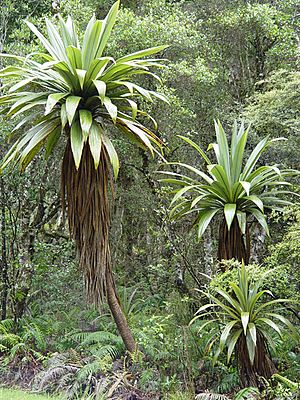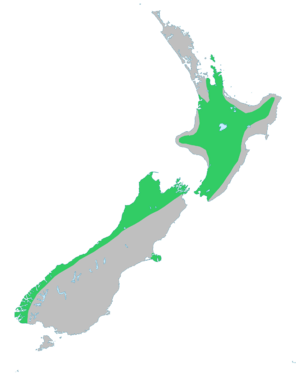Mountain cabbage tree facts for kids
Quick facts for kids Mountain cabbage tree |
|
|---|---|
 |
|
| Scientific classification | |
 |
|
| Natural range of C. indivisa | |
| Synonyms | |
|
Dracaena indivisa |
The mountain cabbage tree (scientific name: Cordyline indivisa) is a special type of tree found only in New Zealand. People also call it the broad-leaved cabbage tree or bush flax. In the Māori language, its name is tōī. It's known for its wide, blue-grey leaves and can grow quite tall.
Contents
Where the Mountain Cabbage Tree Grows
This unique tree lives only in New Zealand. In the North Island, you can find it in areas like the Hunua Ranges and the Coromandel Peninsula. However, it becomes much more common further south, especially around the central Volcanic Plateau.
In the South Island, the mountain cabbage tree is widespread. It grows a lot along the northern and western parts of the island. You might also see it in the drier eastern areas, but it's not as common there.
What the Mountain Cabbage Tree Looks Like
The mountain cabbage tree is easy to spot! It looks different from other Cordyline trees. Its leaves are very wide and have a cool blue-grey color. It also has small flowers that grow in a tight bunch from under its leaves.
This tree can grow up to 8 meters (about 26 feet) tall. Its trunk can be quite thick, from 40 to 80 centimeters (about 16 to 31 inches) wide. Usually, the trunk doesn't have many branches, or sometimes none at all.
The leaves are very long, about 1 to 2 meters (3 to 6 feet) in length. They are also wide, from 10 to 30 centimeters (4 to 12 inches) across. As the tree gets older, its leaves start to droop downwards. They are a beautiful blue-green color and look like broad swords. Each leaf has a clear middle line, called a midrib, which can be red, orange-red, or even golden.
Protecting the Mountain Cabbage Tree
Right now, the mountain cabbage tree is not considered an endangered species. However, some groups of these trees in the northern parts of New Zealand have become much smaller. This is because animals like livestock and goats eat them. For example, goats might have caused them to disappear completely from Mount Moehau on the Coromandel Peninsula.
Since 1987, some Cordyline trees in New Zealand have faced a disease called "Sudden Decline." This disease is caused by a tiny germ called Phytoplasma australiense. Some mountain cabbage trees have died suddenly, both in gardens and in the wild. Scientists think this disease might be the reason, but they are still studying it to be sure.
Growing Mountain Cabbage Trees
Many people think the mountain cabbage tree is a very beautiful plant to have in a garden. But it can be a bit tricky to grow. It sometimes suddenly wilts or dies if it gets too hot or doesn't get enough water.
This tree prefers cool, damp soil and a bit of shade. It's quite easy to grow in the cooler parts of New Zealand. However, if you try to grow it in warmer, lower areas, like north of Hamilton, it's very difficult. Most plants don't live long enough to produce flowers in those warmer places.
Similar Trees
The mountain cabbage tree (C. indivisa) can sometimes be confused with another cabbage tree called Cordyline australis. You might have seen a popular houseplant sold as "Spikes" or "Dracaena Spikes." This plant is actually a young C. australis, but it's often incorrectly sold as Cordyline indivisa or Dracaena indivisa. Dracaena is a plant family that is closely related to Cordyline.
See also

- In Spanish: Cordyline indivisa para niños

